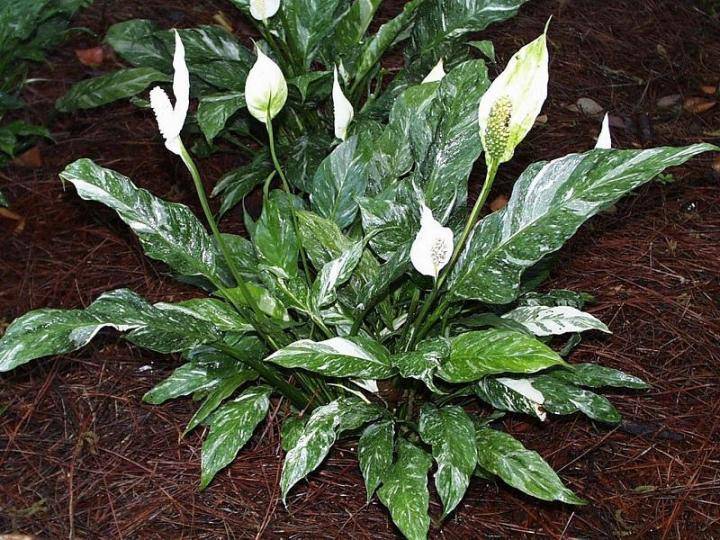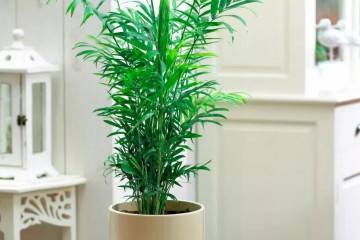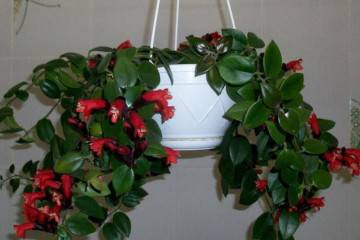Spathiphyllum Domino flower - home care
Content:
Spathiphyllum Domino is a houseplant up to 17 cm high with white cone-shaped flowers, which belongs to the Aroid family. Its distinctive feature is elongated variegated leaves, thanks to which the bush looks spectacular even when not blooming. It is often confused with another species, so before buying, you should familiarize yourself with the difference and care features.
Description of the flower
This green comrade has no healing properties. He, on the contrary, is quite poisonous, so it is worth thinking about breeding it at home, where there are children and animals, a hundred times. But it is scientifically proven that it perfectly cleans the air in the room, neutralizing harmful substances.
There are several other varieties that Dominoes are constantly confused with.
Spathiphyllum Gemini: difference from Domino
Spathiphyllum Gemini is very similar to Dominoes, so they are often confused. But contrary to popular belief, there is a difference between them, they are not the same variety. The bract, a leaf on a leg just below the flower, is oval in Domino, in contrast to Demini. There is also an opinion that Gemini leaves are more pressed, but in practice it all depends on the particular plant.
Another twin brother of Domino's spathiphyllum is the Picasso variety. They differ in the arrangement of variegated specks. The difference is that in Picasso, spots are also present on the perianth, while in Domino it is monochromatic.
Spathiphyllum Domino: home care
This flower is quite unpretentious in content, even a novice florist can handle it. It is also suitable for scattered people who sometimes forget about watering. But, of course, if you take care of it correctly, the flower will look much more beautiful.
- Temperature. It is necessary to provide the spathiphyllum with a stable temperature from 18 ° C to 24 ° C. Drafts and sudden changes in temperature conditions he does not like.
- Lighting. The best option is a lot of diffused light, but without direct sunlight. Partial shade is also acceptable for Dominoes, however, it makes its leaves less bright and negatively affects flowering.
- Watering. In spring and summer, the plant should be watered every 2-3 days so that the soil is constantly moist, because during this period there is an active growth and development. In autumn, the soil should dry out 1-2 cm deep, so the frequency of watering is reduced to once a week.
- Humidity. For spathiphyllum, an air humidity of 40% is suitable. To maintain it at this level, you will have to spray the flower every day in the summer.
- Soil and top dressing. Domino needs light, loose soil rich in nutrients. Peat should occupy at least a quarter of its composition. Top dressing is best done in the spring and summer, about once every two weeks. 1/2 dose of liquid compound fertilizer will do.
- The only difference between summer and winter care is watering. In winter, do not water the plant abundantly so as not to freeze its roots. Fertilizing is also not worth it, because it is at this time in the dormant period.
Bloom
The flowers of spathiphyllum Domino resemble white cones. Against the background of variegated leaves, they look very impressive.The flowering period lasts approximately from May to September.
Before the buds appear, regular watering is required so that the land is in no way overdried. Top dressing should have a large supply of phosphorus and potassium. It is better to remove faded buds, this contributes to the active appearance of new flowers. After flowering, you no longer need to feed, and watering should be reduced.
Reproduction of spathiphyllum
You can propagate a flower in one of three ways.
- Seeds. This method is quite difficult. Seeds deteriorate quickly, so you should pay attention to the expiration dates, it is best to plant freshly harvested seeds. Even a plate is suitable as a container, and the soil should consist of peat and sand in equal proportions. Suitable temperature is 24-25 ° C. You need to water the seeds by spraying from a spray bottle. Care must be taken to prevent mold from developing due to excess moisture.
- Cuttings. If the cutting already has roots, you can immediately place it in the soil, if not, first in a vessel with water or in a special substrate (peat, perlite) so that the roots grow back faster.
- Splitting a flower. You need to remove the flower from the pot and clean the root ball from the ground. It will be better if you moisten it with water first, so that dryness does not cause brittle roots. Then it is necessary to separate with the help of scissors those sections that have three or more leaf rosettes and a sufficiently developed root system. They need to be planted in small pots so that the plants spend their energy on the growth of leaves and flowers, and not on the development of roots.
Spathiphyllum transplant
A pot change should be carried out when the roots become too crowded or the soil deteriorates. It is best to do this in the spring, during the flowering period such manipulations are undesirable.
Step-by-step instructions for transplanting:
- An hour before the transplant, it is good to water the spathiphyllum.
- Gently shake the flower out of the pot, being careful not to damage either the root ball or the leaves.
- Trim off dead pieces of roots.
- Make a drainage layer at the bottom of the new pot, sprinkle moist soil with peat on top. Fill up the roots, lightly tamping the soil. The soil should end at the level of the leaves.
Diseases of spathiphyllum
In growing, growers may face some problems that are associated with improper care.
- The plant sheds buds and leaves. It is necessary to check the moisture content of the soil, usually the reason is excessive dryness. It is important that the soil in the entire pot is moist, otherwise some roots may not get water. If this is not the case, the root may have rotted. Domino should be transplanted into a new pot, after cutting off all diseased areas of the root system.
- The pallor of the leaves is a sign of a lack of sunlight and, possibly, nutrients.
- If there is a draft in the room or the air is too dry, the tips of the leaves dry out and turn brown.
- Falling lower leaves are the work of insect pests. To get rid of them, it is worth using a solution of tobacco crumbs in water or an insecticide if the folk remedy turned out to be powerless.
Spathiphyllum is called the flower of female happiness. There is a belief that he brings peace and family happiness to the house, and where there is a lot of quarrel, he begins to fade. In any case, this is an unpretentious representative of the home flora, which delights the eye not only with flowers, but also with its bright foliage.



















